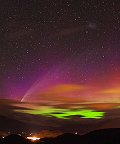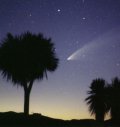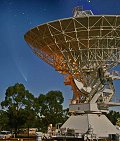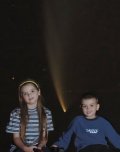| |
Summary:
Comet McNaught swung by the Sun in mid-January
2007. Fierce solar heat turned it into the brightest comet in 40
years; for a few days it was actually visible in broad daylight!
When McNaught emerged from the sun's glare into the skies of the
Southern Hemisphere, the tail alone stopped traffic and was mistaken
for a brush fire, an explosion, a mysterious cloud and probably
many other things never reported. For photographers, it was the
photo-op of a lifetime. Now Comet NcNaught is receding into the
outer solar system never to return -- only the pictures remain. Enjoy
the gallery! |
 |
| |
| |
Photographer,
Location |
Images |
Comments |
|

|
Minoru
Yoneto,
Queenstown, New Zealand
Jan. 30, 2007 |
#1,
#2,
more |
Comet
McNaught lost its tail among the Southern Lights during
a geomagnetic storm over New Zealand.
Photo
details: Pentax
*ist Ds, Sigma
15mm / Takumar
28mm, ISO800, 120s exposure |
|

|
Chris
Picking,
Wairarapa, New Zealand.
Jan. 31, 2007 |
#1,
more |
The
last hour of true darkness for the comet. This is a view
of the southern horizon.
Photo
details: Canon
10D, 18mm
lens, 3 x 3 minute tracked exposures. Panorama created
with PTGui. |
|

|
James Tse,
37 km south of Christchurch, New Zealand.
Jan. 28, 2007 |
#1,
#2, #3,
#4 |
Comet McNaught's
magnitude and size of tail are decaying rapidly with significant
change Within 3 days, you find that it is fading under the
evolution rapidly. It was just visible by our unaided eyes
last night.
Photo
details:
#1:
(25/1/07) Canon
EOS 30D, Canon
EF17-85mm@17 mm, f/4.5, 1600 ISO, 30s.
#2:
(28/01/07) Canon
350D, Nikor
50mm lens f/1.2 @ f/2.8, 800 ISO, 30s
#3:
(28/01/07) Canon
350D, Sigma
EX 8mm lens, f/4, 800 ISO, 4 mins.
#4
(28/1/07) Canon
350D, Nikor
35mm lens, f/2.8, 400 ISO, 4s
|
|

|
Ian Cooper,
Stonehenge Aotearoa, Wairarapa, New Zealand.
Jan. 30, 2007 |
#1,
#2, #3,
#4 |
In the last
hour of dark sky available I mangaged these photos as the
magnificent circumpolar comet, with its beautiful sweeping
30 degree tail, rose in the south east just before dawn
from the Stonehenge Aotearoa observatory site.
Photo
details: Nikon F with a 50mm lens at f/2.8, 12
minute exposure on Fuji Press 800 film. No. 2, 400mm @ f/6.3,
5 mins exposure. No.s 3 & 4, 50mm @ f/2, 40 seconds.
|
|

|
Angel R. Lopez-Sanchez,
Australia Telescope Compact Array (ATCA), Narrabri, NSW, Australia
Jan. 29, 2007 |
#1,
more |
Comet McNaught
C2006 P1 and ATCA interferometre (Narrabri, NSW, Australia)
Antenna 2 at 10h UT of 29 January 2007.
Photo
details: This image is a combination of 18 individual
frames obtained using a Canon
EOS 400D digital camara, 800 ISO, 30 seconds exposure
time per frame.
|
|

|
Sean Quigley,
A few km North West of Two Wells in South Australia.
Jan. 22, 2007 |
#1,
|
A 23 second
exposure with a flash at the end to light up the kids sitting
on my car roof.
Photo
details: Nikon
D70, f/4, ISO800.
|
|

|
Mike Salway,
Lostock, NSW Australia at the IceInSpace AstroCamp (IISAC2007).
Jan. 19, 2007 |
#1,
more |
We wanted to
try for a novelty shot, with my friend Rod "catching the
comet".
Photo
details: Single exposure, flash used. Canon
350D + 75-300mm
lens.
|
|
|
|